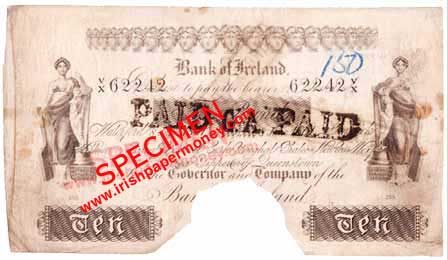
1838 saw the introduction of the iconic Bank of Ireland design of a row of heads of Mercury, the god of commerce flanked by two statues of Hibernia. This basic design remained at the core of the bank's banknote design until 1958, and was continued thereafter in altered form, right up to the present day note issues.
Payable to bearer. Banknotes standardised to a single large size. Uniface. Head Office DUBLIN.
All notes were hand signed. Watermark: bank’s name in a curve, sometimes with a year of manufacture inside the curve.
Row of Mercury Heads across the top of each note. A statue of Hibernia stands on the left and right hand sides. All banknotes are payable in Dublin. Some notes also list other branches in addition to Dublin. This was a prelude to the introduction of the multi-branch General Issue, Series E. Fractional notes, including all Guinea Denominations ceased to be issued after 1845.
Many of the surviving banknotes are contemporary forgeries.
There are five Types by major design variation for Series D banknotes, which as listed below. Little is known about Series D banknotes in general as the notes are very scarce. It is likely that other denominations and subtypes exist of Series D.
Type A. 1838-1842 Hibernia Statues and Row of Mercury Heads
Initial design. Prefix of Letter over Letter plus 5 digit number.
Denominations recorded: £1, 30 Shillings. Other denominations not seen, probably only these three denominations for this type.
Type A1. Extra branch added on either side of Dublin in script typeface.
Position of serial numbers changed to top of banknote.
Bottom area of £1 notes redesigned. Denomination in letters bottom centre of £1, £3, £5, not on 30 Shillings.
Denominations recorded: £1, 30 Shillings, £5.
One or two extra branches added in a script typeface in addition to Dublin in centre of each banknote. Branches are not in alphabetical order.
Type B1. ca1842. 1 branch. This is equivalent to the single branch issues of other banks, payable at the head office in Dublin as well as at the issuing branch.
Type B2. ca1850. 2 branches. The branch pairs differ from banknote to banknote.
Date moved from under 'Dublin' to sit on either side of it, and size reduced slightly.
30 Shilling denomination discontinued.
Denominations recorded: £1.
Wavy design introduced on bottom of £1 notes in place of denomination in words.
Denominations recorded: £1.
'Dublin' in centre of note reduced in size relative to earlier notes and moved up slightly. Type size of the date reduced slightly. Wavy background underprint printed on the bottom of each note in place of denomination in words on £1. Probably also on £3, this denomination not yet seen. £5 and £10 notes also seen, with wavy underprint.
Denominations recorded: £1, £5, £10. The 30 Shillings denomination was discontinued as a result of the Bankers (Ireland) Act 1845 which prohibited the issue of fractional denominations.
Several branches appear on each banknote in addition to Dublin in the centre. There appear to be two regional varieties, a Northern variety listing branches north of Dublin and a Southern variety listing branches south of Dublin.
Other regional varieties are likely as Galway is not included in the lists observed to date.
Type E6n. ca1855. 6 branches in 2 Lines. n = Northern variety.
Type E12s. ca1856. 12 branches in 2 Lines. s = Southern variety.
Type E13s. ca1859. 13 branches in 2 Lines. Queenstown added.
Type A

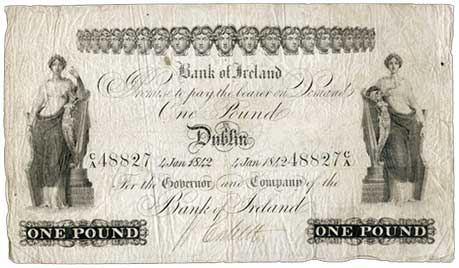
Type B
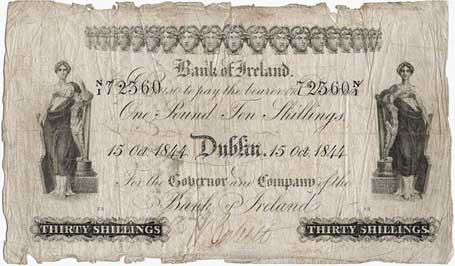
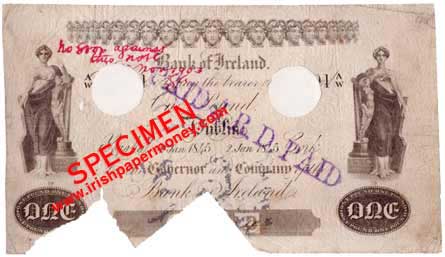
Type C
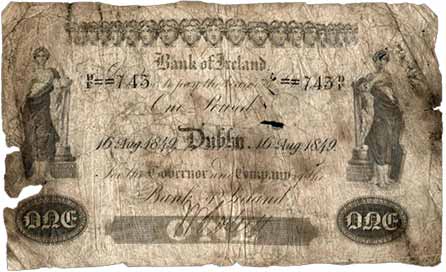
Type D
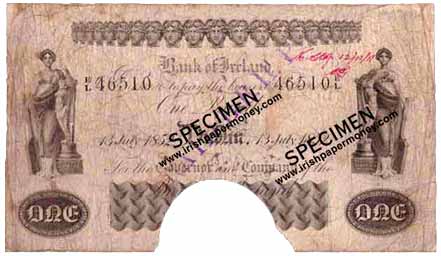
Type E

